At Your Boxes:
Unless you have nest takeover attempts in progress at your Tree Swallow project it may seem a bit quiet now. Most females are spending large amounts of time in boxes incubating their precious eggs. When males are present they perch on or near their box keeping watch, gurgling at their mate, and singing or calling at passing intruders. And when nothing else appears to be happening they often preen their feathers. Although this may seem like a “leisure time activity,” it’s anything but unimportant. Feather Care is absolutely vital for the health and survival of Tree Swallows, one of the most aerial of birds. The photo below was taken by Michael Porter in British Columbia.
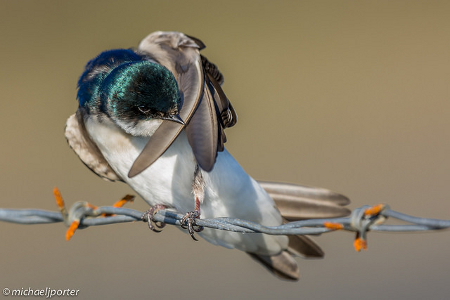
Since swallows perch as they maintain their feathers, the apparent calm of the incubation period is a good time to bring binoculars so you can observe feather care close up.
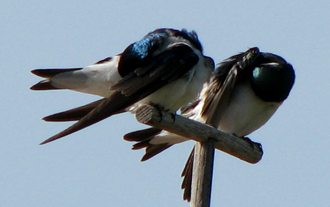
Concepts:
Feathers are truly marvelous things. Note the stiff central “shaft” or “rachis,” on the swallow wing feathers below, and the two “vanes” that protrude from opposite sides of the shaft. Each vane is composed in turn of many smaller “barbs” aligned in parallel rows. What you can’t see are the tiny hook-like “barbules” on each barb that interlock with barbules on adjacent barbs, holding the barbs together like velcro. The picture shows a few feathers whose barbules have become unzipped.
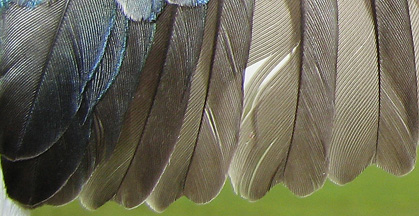
If you have access to a good microscope, remove a feather from a nest lining for a magnified examination. Feather structural intricacy is amazing!
Why is feather care so important for Tree Swallows and other birds?
- Feathers are a bird’s flight surfaces. They streamline, propel, steer, and balance a bird’s body for efficient aerodynamic passage through the air.
- Feathers trap an insulating layer of air next to the skin, keeping body heat in.
- They also form an outer body covering that keeps cold and moisture out, and protects a bird’s thin skin from abrasions and ultraviolet radiation.
- Feathers help members of a species identify each other through their unique colors and shapes, and their use in species-specific behaviors.
- Courtship displays utilize feathers, which can signal an individual’s health and genetic quality to potential mates.
- Feathers may function to identify individuals within social groups, which can help maintain dominance hierarchies.
- Birds often use feathers in aggressive displays. This replaces the need for actual fighting.
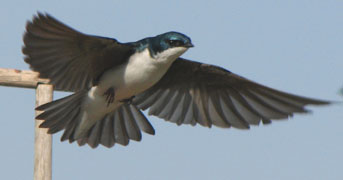
What are feathers made of?
- Feathers are mostly composed of keratin, a tough but flexible protein.
- Bird claws and outer beak coverings are also made of keratin.
- Your own hair and fingernails are made of a slightly different form of keratin.
Are feathers alive?
- No, feathers are non-living tissue.
- Feathers are produced by living cells located in small pit-like follicles in a bird’s epidermis, its outer skin layer.
- The follicles extrude keratin gradually, which pushes out and enlarges the feathers.
- When a feather has reached its full size, the blood supply to the base of the feather shaft is cut off and the shaft base stiffens. The feather is now a fully functional, but non-living, structure.
How do Tree Swallows care for their feathers?
You should be able to see your Tree Swallows:
- Grasp feathers and draw them through their bills one at a time.
- Straighten and arrange their feathers with their bills.
- Fluff their feathers with a shivering shake of their body.
- Spread each wing out over their raised legs one by one.
- Stretch their wings simultaneously up and over their heads.
- Here’s a video of Tree Swallows preening.
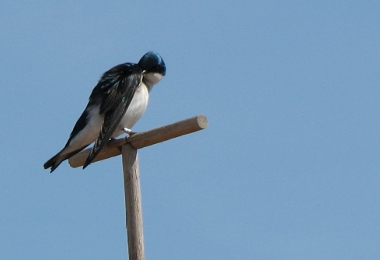
What is the purpose of all this? How do these behaviors improve feather function and benefit the bird?
These actions:
- Zip-up feather barbs that have become separated.
- Return misaligned feathers to their proper place.
- Reincorporate insulating layers of air between feathers.
- Waterproof the feathers.
- Remove dirt and debris.
- Dislodge and remove ectoparasites.
You may have heard that birds have a “preen gland.” What is this, and how is it used in feather care by Tree Swallows?
- A bird’s “preen gland” or “uropygial gland” is a pimple-like structure on its rump. You can see it easily in nestlings, like the seven-day-old below.
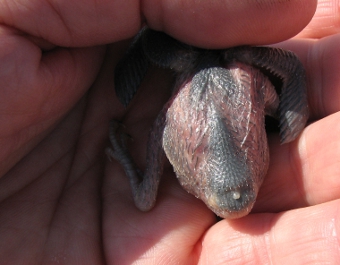
- The preen gland secretes an oil when a bird presses it with its bill.
- The bird spreads the oil onto feathers as it draws them through its bill one by one.
- You should see swallows reach back and touch their rump with their bill to get oil as they preen.
- One of the oil’s main functions is to waterproof feathers. Notice how effectively it causes water to bead up and run off in Pete Luedemann’s beautiful photo below of a swallow perched in an Alberta rain.
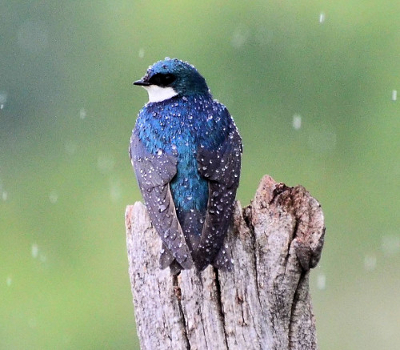
- Preen oil also conditions feathers, preventing them from becoming brittle.
- In addition, preen oil may help keep a bird’s skin supple, and may possess antibacterial and antifungal properties.
Why do the birds scratch their heads and necks with their feet during feather care in Tree Swallows?
- This behavior is also part of skin and feather care in Tree Swallows.
- They can’t grasp some feathers with their bill so they use their foot to transfer preen gland oil to hard to reach spots.
- Scratching can also dislodge ectoparasites.
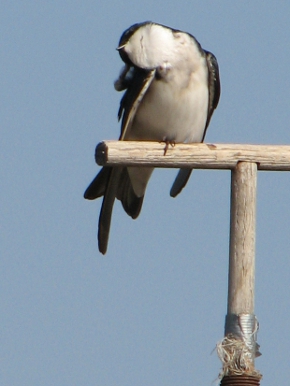
Don’t feathers wear out eventually?
- Yes, they do, despite of all this feather care by your Tree Swallows. The birds subject these thin, light, seemingly delicate structures to constant use and wear. It’s amazing they last as long as they do, but eventually birds must “molt” them.
- Molting is the systematic replacement of all or portions of a bird’s feathers by new ones. In songbirds, molt takes place gradually so they can continue to fly.
- Different songbird species have different timing and patterns of molt, and some species molt more than once a year.
- Molting is “expensive” for songbirds. Replacing old feathers with new requires lots of raw materials and energy, plus it’s harder to fly and keep warm with some feathers missing or only partly regrown.
When do Tree Swallows molt their feathers?
- Because it does demand lots of energy to grow new feathers molt usually occurs when nothing else major is going on in a bird’s life, for instance, before or after nesting, or before or after migration. However, Tree Swallows are exceptions to this rule.
- Adult Tree Swallows have just one complete molt that starts when nesting is almost over and extends over several months into autumn as the birds slowly move south during migration.
- Many other songbirds have a different pattern, with a complete molt after nesting plus a partial molt before the following nesting season begins.
- Juvenile Tree Swallows also have a complete molt that starts soon after they fledge. By October or November young males will have attained the AHY plumage they will retain all their lives and young females their distinctive SY plumage. See Sexing and Aging Tree Swallows for more on this subject.
- The photo below by Jeremiah Trimble shows a molting juvenile Tree Swallow in late August. Note how its faded brownish juvenile feathers have been partly replaced by darker adult ones. Can you tell how we know this bird is a male?
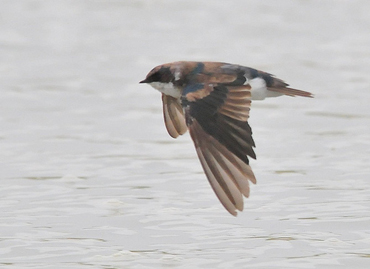
Sometimes birds damage or lose feathers before molting season? What happens then?
- If a whole feather is pulled out or lost, a new one will begin to grow at once from the follicle.
- But if a feather is only damaged or partly broken off with what remains of its shaft still attached, it will not be replaced until the next scheduled molt.
What other parts of their body exteriors do songbirds need to care for?
- Watch to see if your swallows perform other maintenance behaviors besides feather care.
- For instance, do you observe bill wiping (below) and foot picking?
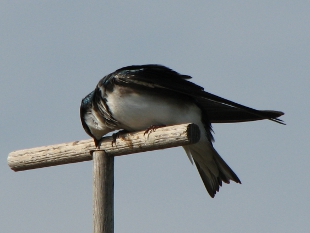
Questions for the next Topic: Hatching and Small Tree Swallow Nestlings
What do you think newly-hatched young swallows are going to look like?
- Lots of feathers or few?
- Eyes open or closed?
- Able to walk or unable?
- Will they be able they move at all?
- Will they be nearly independent or helpless?
- What do you think the young will need to be able to do at hatching?
————————————————————————————-
Home: Tree Swallow Nest Box Projects
Creating Tree Swallow Nest Box Projects
Spring Return
Nesting Season Behavior
Song and Calls
Nest Site Claiming
Pair Formation
Nest Building
Bird Flight
Mating and Paternity
Diary of One Season at Salmon Creek
Monitoring Nest Boxes and Keeping Records
Making Box Checks Keeping Box Records Control Sheets Season Summaries Print Sheets
Banding Your Tree Swallows Banding Adults Banding Nestlings
Tree Swallows in Research Research Bibliography Glossary of Terms